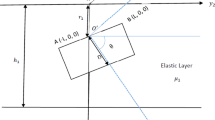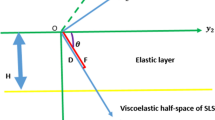Abstract
Square plate models with a diagonally located slit in compression were studied photoelastically. The resulting stress field surrounding the discontinuity (slit) is evaluated before and after seismoactive (seismic-energy-releasing) shear displacement. The mechanism of the fast shear movement (stick-slip), including its radiation properties, in interpreted. The results confirm the existence of a central locked zone in the loaded slit, the limits of which coincide with the initiation points of stick-slip movements. The zone is interpreted as the source of the seismic energy release. The complementary measurements (direct optical and ultrasonic) are presented to verify the results of the photoelastic analysis. The results obtained are discussed in regard to the conclusions that follow from the theory of elasticity.
Similar content being viewed by others
References
Bombolakis, E. G. (1968),Photoelastic Study of Initial Stages of Brittle Fracture in Compression, Tectonophys,16, 461–473.
Brace, W. F., andByerlee, J. D. (1966),Stick-slip as a Mechanism for Earthquakes, Science,153, 990–992.
Byerlee, J. D. (1970),The Mechanics of Stick-Slip, Tectonophys.,9, 475–486.
Duda, S. J. (1965),The Stress around a Fault according to a Photoelastic Model Experiment, Geophys. J. R. Astr. Soc.,9, No. 5, 399–409.
Frocht, M. M. (1962),Photoelasticity, Vol. 1, 2, Wiley, New York.
Košťák, B., andKozák, J. (1984),Photoelastic Analysis of a Seismoactive Crack, Proc. Symp., Optical Methods in Dynamics of Fluids, and Solids, IUTAM, Springerverl., W. Berlin. In press.
Kozák, J., et al. (1981),Laboratory Investigations on Fault Plane Induced Tensile Cracks, Studia Geoph. Geod.,25, 332–342.
Kozák, J., et al. (1982),Seismic Signals Generated by Fault Plane Induced Tensile Cracks, Earthq. Predict. Res.,1 (4), 331–337.
Kozák, J., et al. (1984),Remarks on Seismic Energy Release Related to Strike Slip and Tensile Crack Mechanisms, Studia Geoph. Geod.28, 156–163.
Kozák, J., andŠílený, J. (1984),Seismic Event with Nonshear Component: I. Shallow Earthquakes with Tensile Component. Submitted to PAGEOPH.
Milbauer, M., andPerla, M. (1961),Fotoelasticimetrie a její Aplikace (Photoelasticity and its Applications) in Czech, CSAV, Praha.
Mushkhelishvili, N. I. (1949),Nekotorye Osnovnye Zadachi Matematicheskoy Teorii Uprugosti, (Some Fundamental Problems of the Mathematical Theory of Elasticity), in Russian, Izv. Acad. Sci. USSR, Moscow.
Shamina, O. G. (1981),Modelnye Issledovaniya Fiziki Ochaga Zemletryaseniy, (The Model Study of the Physics of Earthquake Foci), in Russian, Nauka, Moscow.
Šílený, J. (1982),Seismická Aktivita Jednoduchého Tektonického Zlomu, (Seismic Activity of a Simple Tectonic Fault), in Czech, Ph.D. Thesis, Geophys. Inst. Czechosl. Acad. Sci. Prague (not published).
Author information
Authors and Affiliations
Rights and permissions
About this article
Cite this article
Košťák, B., Kozák, J. & Lokajíček, T. Contact conditions on seismoactive faults. PAGEOPH 122, 680–693 (1984). https://doi.org/10.1007/BF01101874
Received:
Revised:
Accepted:
Issue Date:
DOI: https://doi.org/10.1007/BF01101874




